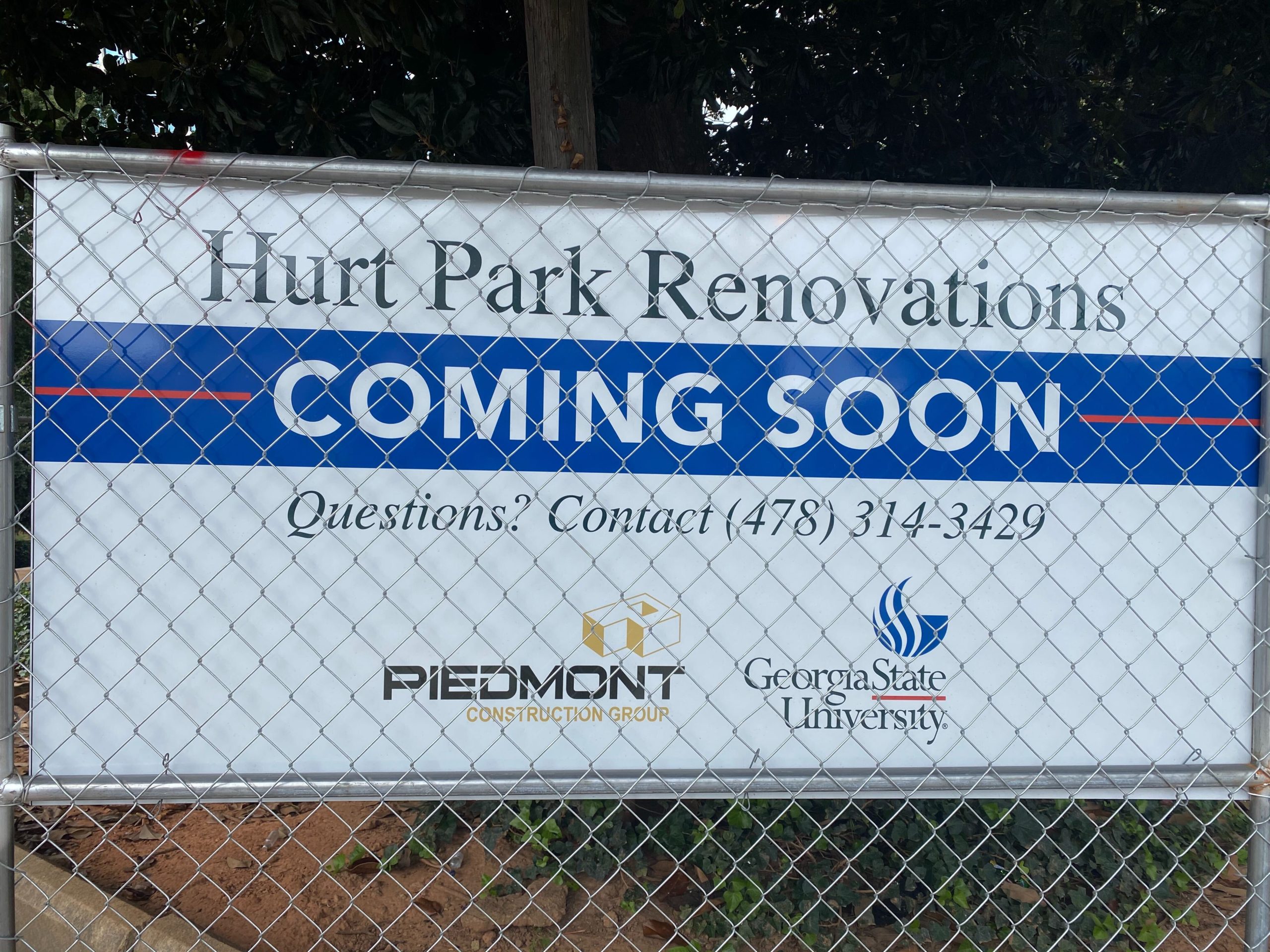
On Aug. 27, Hurt Park was publicized for being fenced off for renovations. The homeless who once slept in Hurt Park now sleep on its sidewalks, where police occasionally patrol early in the morning and tell them to scatter.
Many Atlantans have concerns over how homeless people, now literally put on the streets, are treated.
The Architects
While the City of Atlanta owns Hurt Park, Georgia State operates it by maintaining the park’s cleanliness and safety. The Piedmont Construction Group is renovating the park for Georgia State.
Founded in 1995 by David and Scott Thompson, Piedmont has worked on at least 112 architectural projects throughout Georgia.
Piedmont Construction Group has renovated cafeterias, libraries and classrooms at numerous universities, including Middle Georgia State University, Georgia College & State University and the University of West Georgia. The construction group has also built and renovated lofts throughout Atlanta.
The Plan
Last year, Georgia State sent an application to the City of Atlanta’s Urban Design Commission asking for its review of and comment on the renovations. The commission was supposed to finish on Sept. 11 but deferred it to Sept. 25.
The park was known for its untidiness; blankets, socks and cardboard were a common sight. The unkept ground and broken water fountain were sights that marked students’ class commutes. According to the proposal by Georgia State, renovators would repave the walkways, repair the fountain and increase security patrols.
The Urban Design Commission was concerned with the fence design for the renovation, which was to stretch around the perimeter. But the Department of Parks and Recreations had preliminarily approved the design.
The commission debated with the idea because they believed that the perimeter fence “would … [be] uninviting to visitors and would lead to general disuse of the space.”
“The City [of Atlanta] should be held to a higher standard of urban design,” the Commission’s Staff Report stated. “As such, [we] strongly encourage [Georgia State] to pursue alternative designs [that] do not include a perimeter fence with locked gates.”
The commission also predicted that the homeless people in Hurt Park would “move to neighboring spaces and spread the issue [of homelessness] throughout the city.” The commission believes that the renovation does not directly address the issue.
“Many cities are exploring [ways to] address [homelessness] by…connecting homeless persons with services and organizations that can [help them],” the commission said. “[We] … strongly encourage [Georgia State] to research these methods and consider their use … for the park.”
The Response
Much of the criticism from Atlantans isn’t about the renovations themselves but, rather, the fate of the homeless as a result of the construction work.
On Feb. 5, when Panther Report News reported on the release of blueprints for the renovations, Atlantans were receptive.
“Can’t wait to go back,” Khoa Tran, former art director of Atlanta magazine, said.
Love Beyond Walls, a nonprofit organization based in Atlanta, posted a picture to Instagram that showed the Georgia State sign behind Hurt Park’s chain-link fence.
“Hundreds of people experiencing homelessness have lost a place where they can find [life-sustaining] resources and a place to rest due to this closure,” the post stated.
Others have expressed the same sentiment across social media, with one Atlantan posting a video of himself on the sidewalk of Hurt Park.
“This [is] how they do people,” he said.
Hurt Park Today
On Sept. 6, the lawn of the park was pristine and manicured as the commission prepared for renovation. There was no trash in sight, let alone people. Items like lotion, soap and wrappers could be found around the park’s fence, but the park itself was spotless.
Eugene Lawrence, a homeless person who stayed in Hurt Park, picked up his cardboard from the sidewalk and headed to West End.
“Nothing happens in downtown,” he said.
He pointed out a cop cruiser that parked in a spot convenient for looking out for civilians staying too close to the park.
“They runnin’ peoples off,” he said.
Lawrence ended up on the street when his apartment burnt down. Instead of waiting for repairs, he decided he’d fare better staying on the street until he could get another place.
Lawrence said that the homeless now congregate in other places, like churches. They would hang around on the outside; however, they don’t really go inside.
A few other homeless people like him surrounded Hurt Park, though hundreds more are scattered throughout the city.
In January, Partners for Home, a nonprofit charity based in Atlanta, identified 939 unsheltered people; around 31% were chronically homeless.
Partners for Home gathered this data by asking the homeless people to complete surveys.
The number of reported homeless in Atlanta has decreased. In 2016, the number of homeless encountered was 838; in comparison, the figure was 1,587 in 2011 — almost twice as many.
Even so, there are still hundreds of homeless people on the streets of Atlanta, and Atlantans feel the fence is part of the problem rather than the solution.
An EPIC Solution
Fidah Arman and Joshua Krivanek are Georgia State students who lead the Homelessness Project Lab, a group of projects dedicated to researching homelessness and presenting alternative solutions and policies to solve the issue.
The lab is part of the EPIC program, which began in the fall last year. On Sept. 10, twelve students in the lab met in a WebEx to discuss research ideas. One student mentioned how hard it was for ex-convicts to integrate back into society, due to their discrimination under the law.
Arman criticized the fence that was put around Hurt Park, believing that there has to be a better solution.
“The money that was spent to put that fence up could’ve been put towards resources that alleviate homelessness,” she said. “So, instead of putting … this border around the problem and trying to wash it away, we could actually come together and say, ‘Hey, here’s a problem and instead of turning a blind eye to it, these are things that we can do.’”
